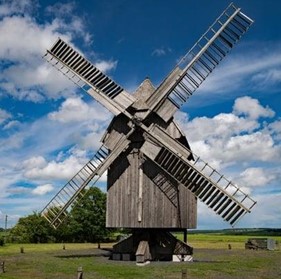- Definition and Types of Energy
- Myths And Misconceptions About Energy
- The Relationship Between Energy and Environment
- Climate Change and Carbon Footprint
- Greenhouse Gas Effect
- The Role of Human-Induced Greenhouse Gases and Energy Consumption
- Energy Efficiency and Sustainability
- Renewable Energy Sources and Future Perspectives
- Play and Learn
- Solar Energy Conversions
- Solar Energy Worldwide
- Solar Energy in Partner Countries
- Positive and Negative Impacts
- Technologies for Harnessing Solar Energy
- Solar thermal energy technologies and applications
- Electricity Generation Methods
- Passive Heating and Cooling of Residences with the Sun
- Concentrator solar power (CSP) systems and electricity generation
- Systems and Applications That Generate Electricity directly from solar rays
- Photovoltaic Cells and Panels
- Domestic PV Systems
- Off-Grid PV Systems
- Hybrid Connected Systems
- Materials Used in PV Cells
- Play and Learn
Wind Energy in the World

The oldest machine that uses wind energy is the windmill. It is thought to have been used in Alexandria approximately 3000 years ago. It is known that the Turks established windmills in 640 and that they spread to Europe with the Crusades. According to written documents, windmills were used between Afghanistan and Iran in 644 AD. Windmills were used in China to irrigate rice fields between 750-850. While the windmills used in the East had a vertical axis, they were developed by making them horizontal in the West. The first horizontal axis windmill was used in the Kingdom of Normandy in 1180. Machines that used wind energy were developed in the Netherlands in the early 18th century and in Germany in the late 19th century. In 1850, American windmills with multiple wings and wind guides began to be used. The use of wind energy in terms of electricity generation developed after the first power plant was established in New York in 1882.
Wind energy was first used to generate electricity in Denmark in 1891. In the 1910s, electricity use became widespread in large cities, but wind energy remained in the background due to the economics of petroleum-based fuels at the time. Wind energy began to develop rapidly in the 1990s and became widespread in America and Europe. In recent years, it has gained importance in Asia with the intensive use of China. The installed wind energy capacity, which was 17 GW in 2000, increased to 600 GW by 2024. In 2024, 70,000 MW of electricity was generated from wind turbines, increasing the total world wind energy capacity to 600,000 MW. For many years, Germany was the country with the largest installed wind energy capacity in the world, but in 2008, the USA surpassed Germany. In 2010, China made a major breakthrough and took first place. China ranks first in the world in wind energy production with a capacity of 200 GW by 2024. China is followed by the USA, Germany, India, Spain, England, France, Canada and Denmark.